




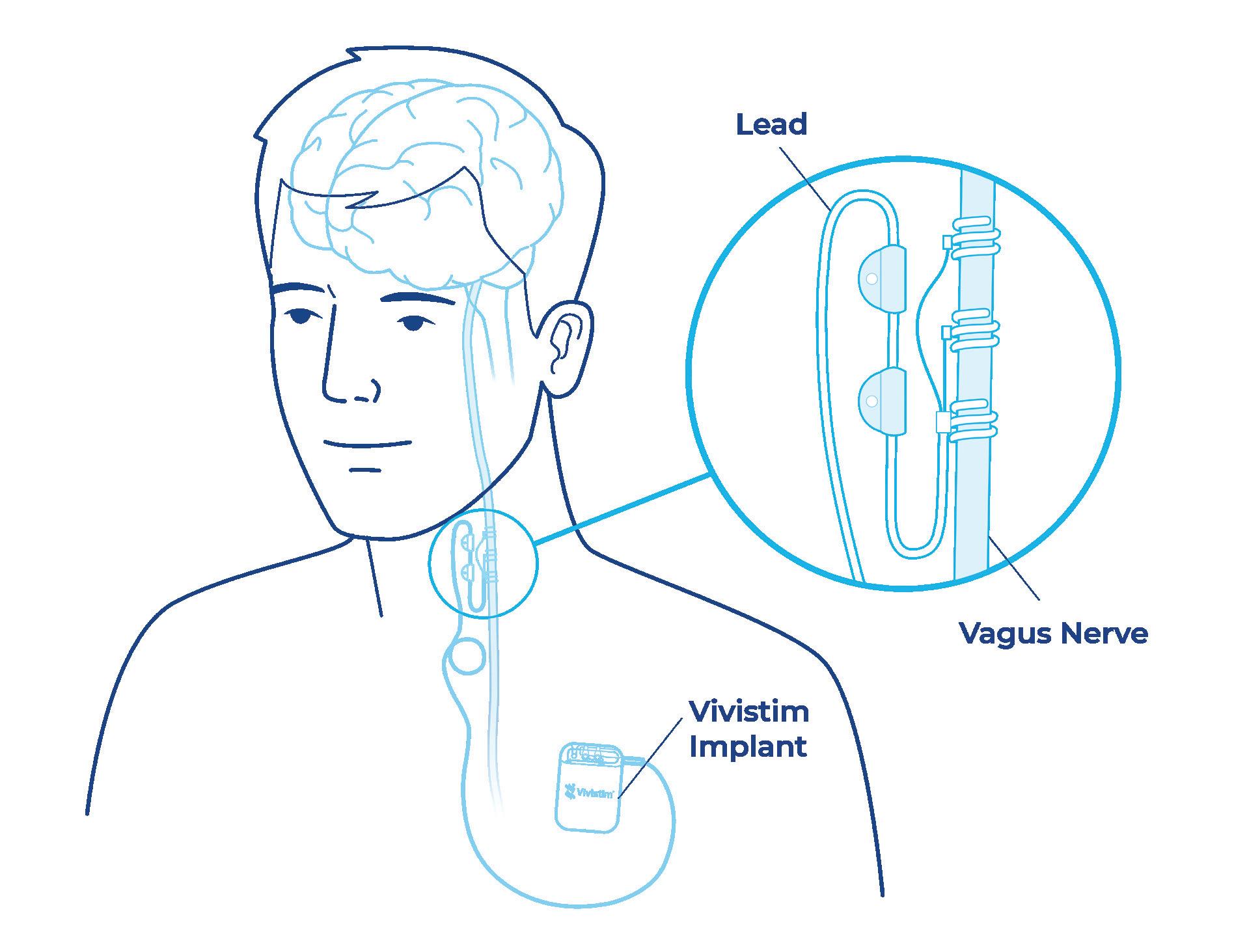
Ashlie Broadhurst and her team of therapists at the Shirley Ryan AbilityLab at Silver Cross in New Lenox have seen firsthand the frustration of stroke patients who hit a plateau in their ability to regain mobility in their arms and hands, even after weeks of therapy.
Now, there is hope for even better outcomes, said Broadhurst, Clinical Manager of Outpatient Rehabilitation at the Shirley Ryan AbilityLab (SRAL) at Silver Cross.
Vagus Nerve Stimulation has been used for years to treat patients with seizures, depression and other neurological disorders. In August 2021, the FDA approved Vivistim – an implantable Vagus Nerve Stimulator that gets paired with occupational therapy – to help bring stroke patients’ arm function to the next level. How Vivistim Works
If a patient qualifies for Vivistim, a doctor implants a device under the left side of the chest in an outpatient procedure. The device delivers a gentle pulse to the vagus nerve while the patient performs a specific task such as putting on a hat, brushing hair or cutting food.
This simultaneous pairing of the rehab exercise with vagus nerve stimulation releases neuromodulators that help create or strengthen neural connections, improve
upper limb function and increase the relevance of occupational therapy.
At home, the stroke survivor can swipe the Vivistim magnet over the device to activate the system during daily activities and exercise. The at-home Vivistim Therapy, in conjunction with in-clinic rehabilitation, helps stroke survivors get back to doing what matters most to them while enhancing their quality of life.
Broadhurst learned of Vivistim last year from a former Silver Cross volunteer who now is an occupational therapist working for the company that developed the system. After a presentation, she and two of her therapists trained in using Vivistim in conjunction with therapy.
She and her team are ready to work with qualified stroke patients.
“I’ve heard and seen the patient stories following the combined therapy. This is really exciting for chronic stroke patients who have hit a plateau in their therapy,” she said.
“We have been spreading the word about Vivistim to patients and to their neurologists,” she added.
Are You a Candidate for Vivistim?
Age isn’t a factor, Broadhurst added. The ideal candidate is at least six months post-stroke and has moderate to severe
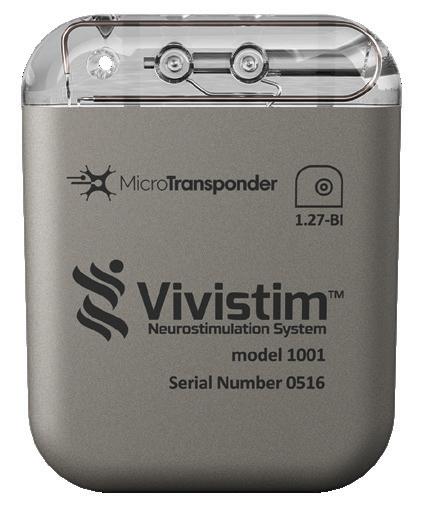
upper extremity impairment. Patients also must be able to handle surgery to implant the device, and, she adds, be motivated to complete the therapy regimen.
Following the Vivistim placement procedure, patients can now be scheduled to complete their outpatient occupational therapy for 90-minute therapy sessions three times a week for six weeks, right at the SRAL Outpatient Therapy Clinic at Silver Cross.
“There are currently surgeons throughout Chicagoland performing this procedure,” Broadhurst said. “I’m sure there are people in our area who qualify for the procedure who don’t want to drive in to Chicago three times a week for therapy. They want something closer. Now they have it right here with us.”
To learn more about Vivistim Therapy, please visit www.vivistim.com, or call (844) 848-4784. To schedule an appointment for occupational therapy with a physician’s order at the Shirley Ryan AbilityLab at Silver Cross, call (815) 300-7110.

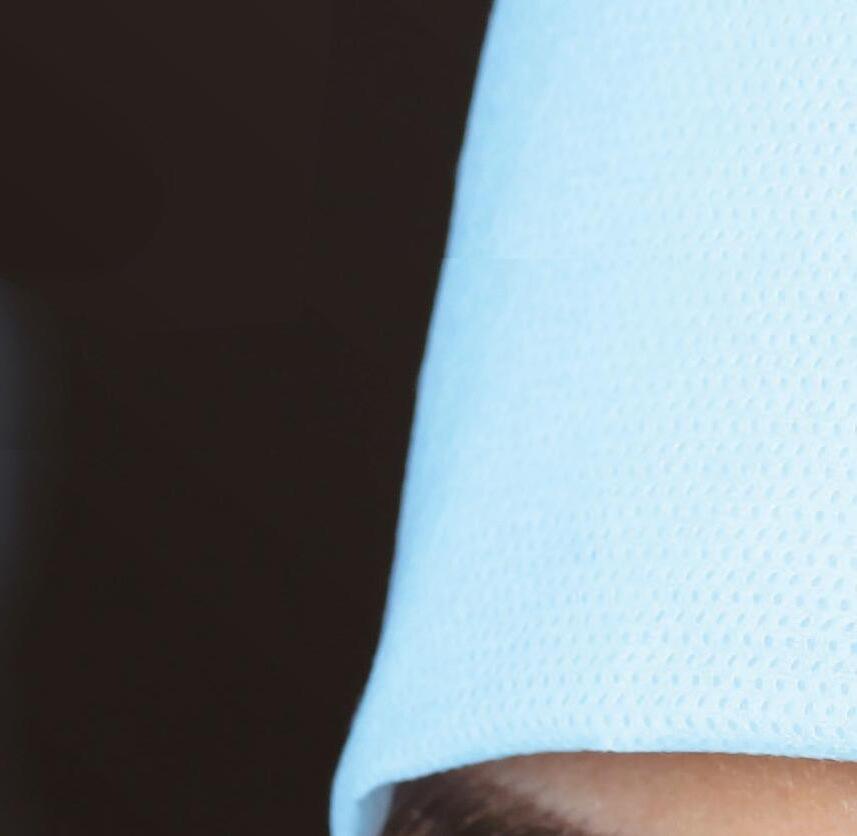
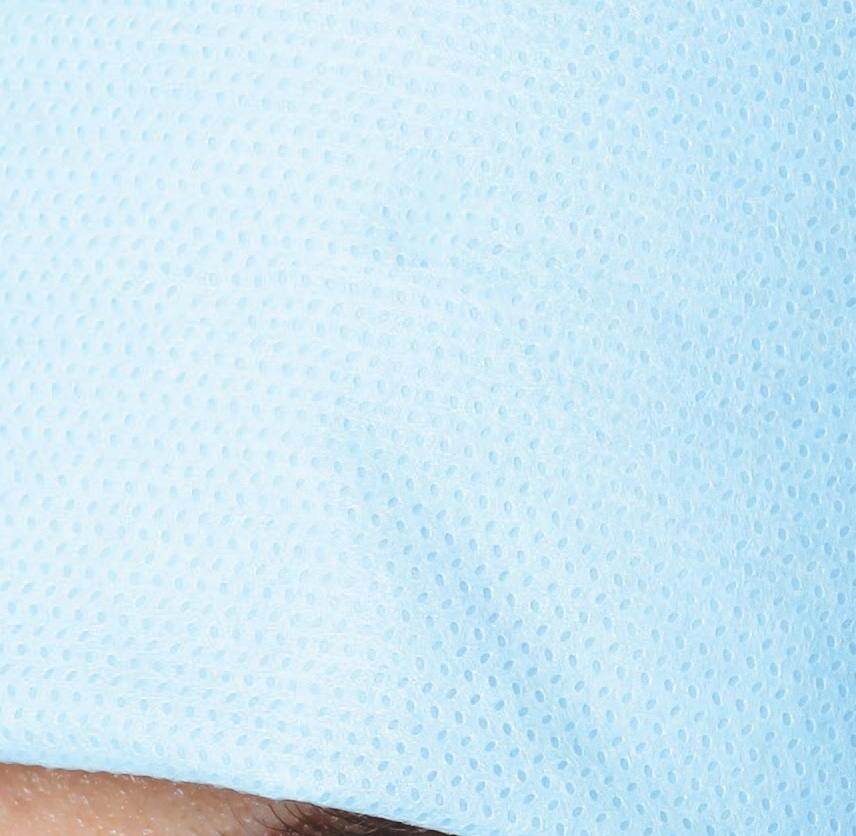










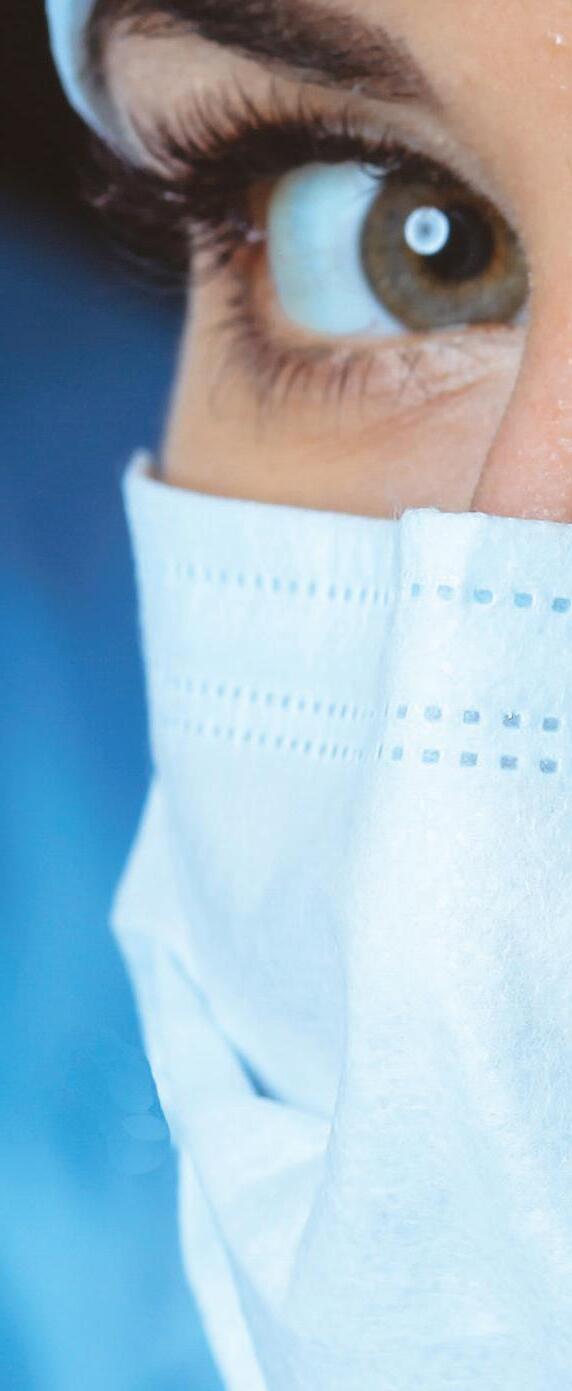

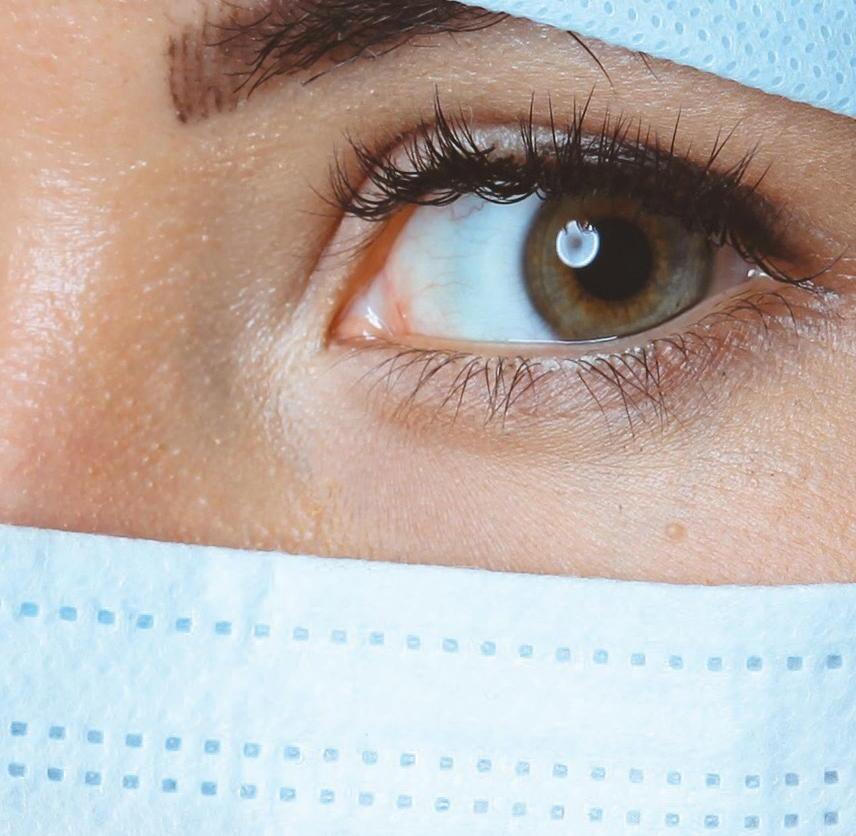


UNIQUE INDIVIDUALS WHO PROVIDE SPECIALIZED MEDICAL SERVICES
Matthew Reynolds, M.D., Ph.D., is a neurosurgeon and neuro-endovascular surgeon specializing in the treatment of neurological disorders of the brain and spine.
He is board-certified in both neurosurgery and minimally invasive neuro-endovascular surgery. His interests and expertise include brain tumors, carotid artery disease, vascular disorders of the brain/spine, ischemic stroke, hemorrhagic (bleeding) stroke, hydrocephalus, Chiari malformations, pseudotumor cerebri, spinal disorders, and general neurosurgery.
Dr. Reynolds graduated with highest distinction from Northwestern University Medical School in 2008, followed by Neurosurgery residency training at Washington University in St. Louis (Barnes-Jewish Hospital). Dr. Reynolds then completed two additional post-residency fellowships in Cerebrovascular Neurosurgery (Emory University) and Neuro-Endovascular Surgery and Neurocritical Care (Thomas Jefferson University).
Dr. Reynolds works in close collaboration with our existing team of neurological experts at the Midwest Institute for Neurosciences at Silver Cross Hospital.
About the Midwest Institute for Neurosciences at Silver Cross Hospital
At the Midwest Institute for Neurosciences at Silver Cross Hospital, our goal is to make sure that you receive the right treatment at the right
time for brain and spine disorders, including stroke.
You’ll find highly trained experts that include board-certified neurologists, neurosurgeons, neuro-endovascular surgeons, emergency medicine doctors, and physical medicine and rehabilitation specialists who can diagnose and treat all types of neurological conditions:
• Preventing strokes and halting them in their path.
• Diagnosing and treating neck and back injuries, brain tumors, cerebral vascular malformations, aneurysms, and blockages in the arteries of the neck or carotid arteries.
• And providing the necessary rehabilitation.
Experience & Expertise:
You can feel confident you’ll get top-quality brain and spine care at the Midwest Institute for Neurosciences at Silver Cross Hospital because we:
• Provide advanced stroke care 24/7 through our collaboration with University of Chicago Medicine, including tele-stroke monitoring in our Emergency Department.
• Offer thrombolytic or clotbusting therapies as well as the most advanced interventional endovascular procedures to treat high-risk stroke patients.
• Offer the latest rehabilitation services through our partnership with the Shirley Ryan AbilityLab —ranked the best rehabilitation

hospital in the U.S. by U.S. News & World Report every year since 1991, allowing patients to recover close to home at Silver Cross Hospital.
• Are designated as a Primary Stroke Center by The Joint Commission and The American Heart Association/ American Stroke Association.
• Received the American Heart/ American Stroke Association’s Get with the Guidelines Stroke Silver Plus Quality Achievement Award.
• Recognized as a Blue Distinction Center for Spine Surgery by Blue Cross and Blue Shield of Illinois.
For more information, visit silvercross.org
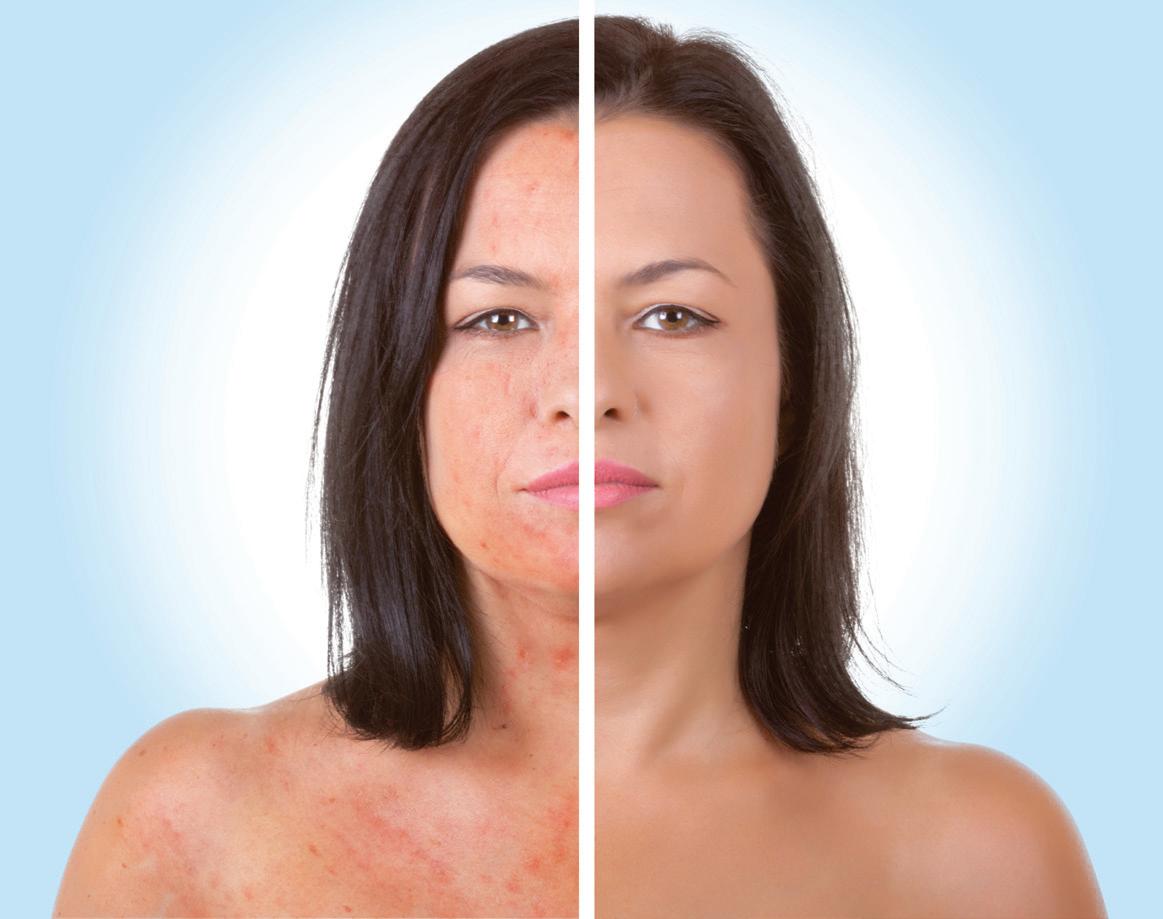
If your skin is not looking its best, perhaps due to the aging process or a recent weight loss, you may be searching for a way to have it tightened and smoothed. A microneedling treatment available at Eterna MedSpa & Laser Vein Center is doing wonders to rejuvenate the skin with natural-looking results.
Morpheus8 utilizes radio frequency energy to remodel and contour the face and body via subdermal adipose (body fat) remodeling.
“Morpheus8 goes deep into the skin and fatty tissue, which morphs the aging face into a smooth appearance,” explained Kathe Malinowski, lead esthetician and Marketing Manager for Eterna MedSpa & Laser Vein Center.
Morpheus8 is effective for treating a variety of concerns, including wrinkles and fine lines, acne scars, stretch marks, surgical scars, and other skin texture issues.
How is it different from other microneedling treatments?
“Morpheus8 is unique because it can penetrate up to 4 mm deep, so it goes deeper than any other microneedling device,” added Malinowski. “By targeting the deeper layers of skin, the building blocks will reorganize themselves in a natural anti-aging process.”
The non-surgical and minimally invasive treatment is compatible with all skin types and tones. A topical anesthetic will be applied to the treatment area to numb the skin.
“Patients do not feel the microneedles,” said Malinowski.
Areas that can be treated with Morpheus8 include the face, neck, arms, flanks, and stomach.For optimal results, clients may need up to three treatment sessions, depending on the severity of their skin condition. While visible results can be seen within a few days, it is typically after three weeks that the most noticeable results appear. Additionally, improvements continue up to three months after treatment.
Wondering if Morpheus8 will work for you? Call Eterna MedSpa & Laser Vein Center to set up a free consultation.
For more information, please contact:
Eterna MedSpa & Laser Vein Center
217 Vertin Boulevard Shorewood, IL 60404
815.254.8888 : https://www.eternalaser.com/
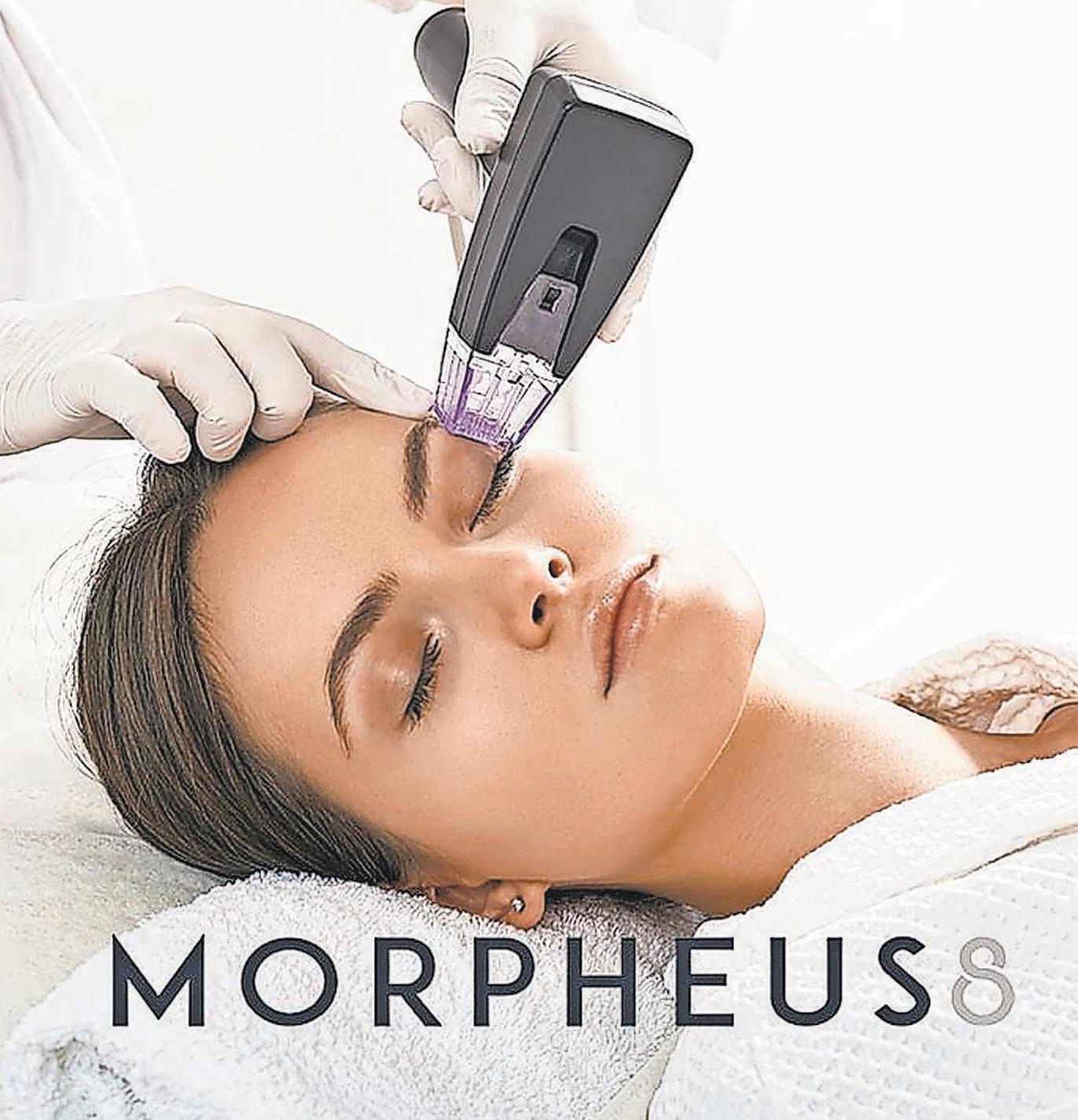
MORPHEUS8 is a game-changing fractional skin treatment that uses MICRO-NEEDLING along with RADIOFREQUENCY to deliver energy deep into the tissue and stimulate COLLAGEN PRODUCTION.
SKIN-TIGHTENING BENEFITS OF MORPHEUS8 REDUCES FINE LINES and WRINKLES on face, neck and decolletage. LIFTS LOOSE, SAGGING SKIN of the face, neck and jawline. TIGHTENS SAGGY and CRINKLY SKIN of arms, chest, abdominal areas and knees.
Any adult who is in GOOD HEALTH and would like to improve the skin laxity on their face or body.
No, a numbing cream will be applied to ensure OPTIMAL COMFORT.
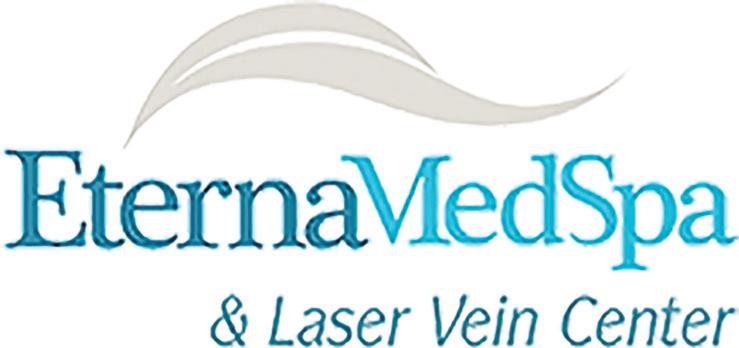


This year marks the 5th anniversary of Silver Cross Hospital’s open-heart surgery program, now one of the busiest in the state of Illinois. It’s also the 1st anniversary of the hospital’s Advanced Heart Failure Clinic, which is making tremendous strides in elevating the quality of life while preventing repeat hospitalizations for those with this chronic condition.
More than five years ago, Silver Cross Hospital’s late President and Chief Executive Officer Ruth Colby had a vision for bringing the best heart care possible to patients in Will County and the surrounding areas. So Silver Cross partnered with Cardiothoracic & Vascular Associates and renowned cardiothoracic surgeon, Dr. Pat Pappas, to develop an open-heart surgery program at Silver Cross Hospital.
“To have a physician of his caliber, one who has been practicing more than 30 years, has developed numerous programs from scratch and is an award-winning educator of the next generation of cardiac physicians, has been transformational,” said Marybeth Antone, Vice President of Clinical Operations at the 348-bed hospital.
The heart surgery program performs 300 surgical cases each year and is part of the Midwest Institute for Heart at Silver Cross. The institute brings together experts from multiple specialties to deliver advanced and high-quality heart care across the continuum.
This continuum of services includes preventive services, cardiology, interventional cardiology, electrophysiology, heart failure, minimally invasive heart procedures, cardiac surgery, cardiac rehabilitation and more. “In just five short years, the Midwest Institute for Heart at Silver Cross has
become a destination program for patients in need of heart care and delivers nationally recognized outcomes,” Antone said.
To celebrate the program’s success and to bring awareness to heart disease and prevention, Silver Cross is bathed in red spotlights during February, American Heart Month. This is the third year in a row the hospital has lit up the front of the hospital red.
Silver Cross Advancing and Earning Accolades for Heart and Surgical Care
For the past five years, Silver Cross has been among the busiest heart hospitals in Illinois, ranking in the top 10 hospitals for number of heart surgeries, and recently was named the No. 1 Hospital in Illinois for Surgical Care by Healthgrades, the leading online database used by consumers to choose a hospital or doctor. That ranking includes superior clinical outcomes for 15 different types of surgery, including heart bypass surgery and heart valve surgery.
Healthgrades Director of Quality Solutions Nicole Patzer visited Silver Cross in January to officially present the award to the hospital. In her remarks, Patzer called Silver Cross “a role model for healthcare in America.” She cited the hospital’s superior patient outcomes and paraphrased the Silver Cross tagline, adding, “This is the way
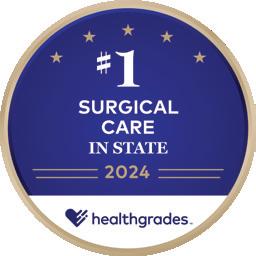


patients should be treated. To be ranked #1 in the state for surgical care specifically is an extraordinary feat because it is the specialty with the widest lens. A hospital ranked in surgical care must have superior clinical outcomes across 15 of the most common in-hospital surgical procedures in the US. The award is based on hospitals with the highest volume-weighted average of these areas, (which is) no easy feat.”
“It truly takes a village,” Antone said. “Our exceptional surgical staff work side by side with the surgeons and anesthesia, but the patient experience and ultimate outcome is the result of support from many different people: our Sterile Processing Department staff who prepare the sterile supplies and instrumentation used in surgery; our Surgery Pre-Post Recovery team who prepare the patient before their surgery and provide emotional support during a very vulnerable time; our Post Anesthesia Care Unit staff who recover patients immediately post-op as they emerge from anesthesia; and our inpatient surgical nursing unit staff who care for the patient before their discharge home.”
She added, “Of course, the team is fully supported by our Administration and our Board. We are fortunate to have extremely talented surgeons who choose our hospital for the surgical care of their patients. I am so honored to have received this award on behalf of the entire team!”
Since the program’s inception in May 2019, the hospital has performed more than 1,100 open heart surgeries, more than 120 transcatheter aortic valve replacements (TAVR), which debuted in 2021, and nearly 200 aortic valve replacements.
Silver Cross is also advancing in other areas across the heart care continuum. Advanced heart failure is complex and has a high readmission rate, which is why the Midwest Institute for Heart at Silver Cross developed a Heart Failure Clinic in 2023. The clinic has a dedicated nurse practitioner, and cardiologists fellowship-trained in heart failure, who partner with patients and their cardiology teams to closely monitor symptoms virtually, provide


education and coordinate timely care to prevent a hospital readmission.
In December 2023, Silver Cross became the first site in the world to implant a heart failure device in a patient enrolled in the groundbreaking Proactive 2 Heart Failure Study.
Miesha Landers, Manager of the Silver Cross Cardiovascular Unit, is passionate about leading her team of compassionate and highly skilled critical care nurses whose focus is on providing excellent care and making sure that patients are well educated about what to expect before and after their heart procedure at Silver Cross.
“It makes me proud when I receive letters from former patients telling me how thankful they are for the nurses who cared for them here,” she said. “We have an amazing heart program and a fantastic team. I’m very proud to be part of it.”
According to the Centers for Disease Control and Prevention, heart disease is the leading cause of death for men, women, and people of most racial and ethnic groups in the United States – and has been since 1950. One person dies every 33 seconds in the United States from cardiovascular disease.
In the United States, someone has a heart attack every 40 seconds, and one in five heart attacks is silent, which means the damage has been done, but the person is not aware of it.
Early detection is key to preventing heart disease, especially in high-risk candidates. High blood pressure, high blood cholesterol and smoking are key risk factors for heart disease, as well as family history.
Silver Cross Hospital offers a number of preventive heart services such as the $49 Heart Scan, which can show calcium build-up, an early indicator of heart disease.
For more information, visit www.silvercross.org/heart
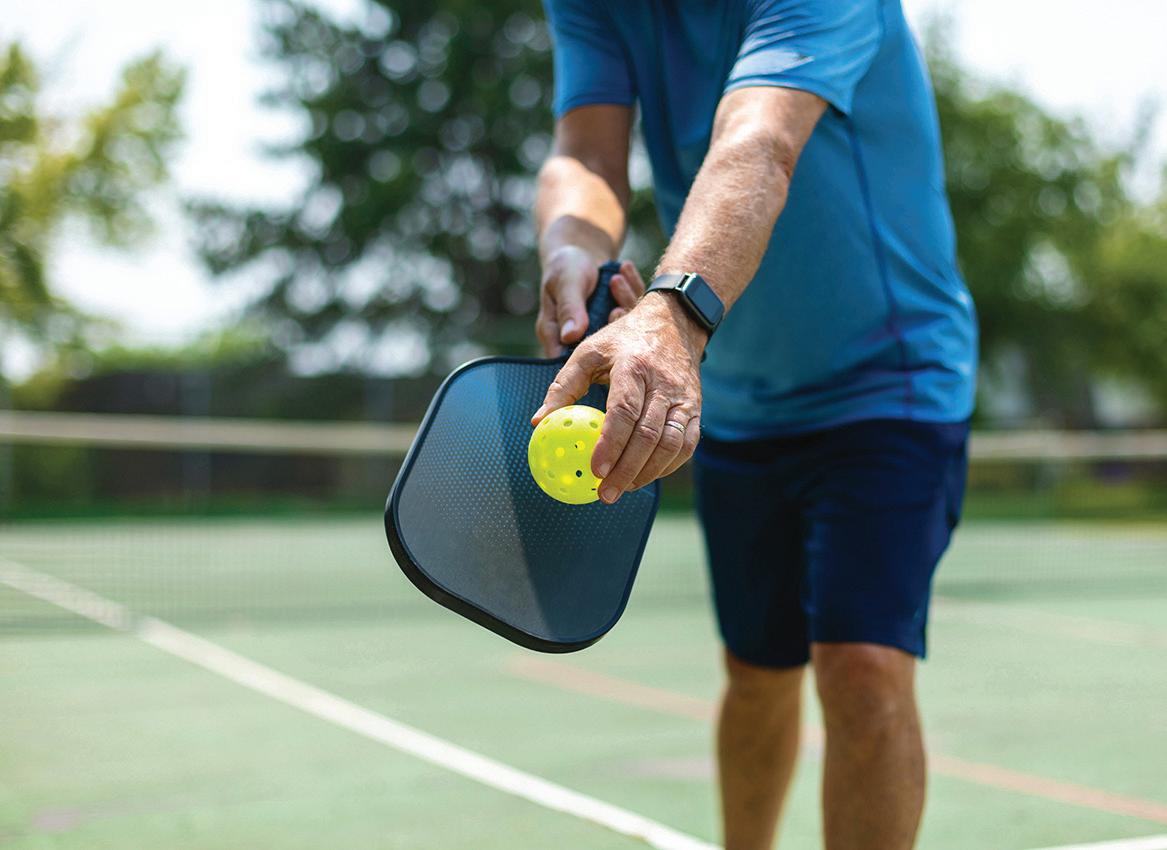
According to the 2023 Topline Participation Report from the Sports & Fitness Industry Association, pickleball participation grew by 159 percent between 2019 and 2022. Such figures are a testament to the popularity of a sport.
The thrill of competition and the joy of social interaction undoubtedly have contributed to the popularity of pickleball, but those are not the only benefits to participating in this fast-growing sport. Indeed, there are many potential health benefits to pickleball as well.
• Pickleball provides a fun way to embrace physical activity. It’s easy to lose interest in an exercise regimen characterized by time on a treadmill and traditional strength training in a gym setting. Though cardiovascular exercise and strength training are vital components of successful exercise regimens, it’s important that individuals make their fitness routines enjoyable, which increases the likelihood that they will remain committed to less sedentary lifestyles.
• Pickleball provides social benefits. According to Duke Recreation & Physical Education at Duke University, pickleball has earned a reputation as an inclusive, community-building activity. The socialization aspect of pickleball should not be overlooked when discussing the health benefits. According to the Centers for Disease Control and Prevention, loneliness can increase a person’s risk for mental health issues like depression and additional problems like heart disease, dementia and stroke. By engaging in social activities like pickleball, individuals can reduce their risk for loneliness, which can improve their overall quality of life.
• Pickleball can lead to a healthier heart. A study from Apple that is examining the effects of pickleball participation on heart health has thus far found that playing pickleball helps players reach moderate to vigorous heart rate zones. Cardiologist and Harvard Medical School professor of medicine Dr. Calum MacRae notes that ample time in moderate heart rate zones has been found to improve cardiac fitness.
• Pickleball can benefit brain health. MacRae, one of the Apple study’s lead investigators, notes that pickleball is one of various activities that also can improve memory and recall over time. The physical benefits of pickleball may not be lost on players, but some may be surprised to learn the sport offers cognitive health benefits as well. A 2023 study published in the journal Frontiers in Psychology found that pickleball participation led to significant improvements in personal well-being, life satisfaction and happiness.

The great outdoors beckons billions of people across the globe every day. There’s much to be gained from spending time outdoors. According to the American Psychological Association, exposure to nature has been linked to improved attention, lower stress, improvements in mood, and reduced risk of psychiatric disorders. With so much to gain from spending time in the great outdoors, it’s no wonder so many people embrace opportunities to get outside. When doing so, it’s important that individuals take proper precautions, such as wearing sunscreen and staying hydrated. But it’s equally important to protect your eyes before soaking up some springtime and summer sun.
• Purchase prescription sunglasses, if necessary. Sunglasses are vital to protecting the eyes from the sun’s ultraviolet (UV) rays. If you wear prescription eyeglasses indoors, then you should also wear prescription sunglasses when spending time outside. Even contact lens wearers may want to invest in prescription sunglasses for those times when they’re engaging in physical activity outdoors. Sweat makes its way into the eyes when exerting oneself outdoors, and that can make contacts uncomfortable. Airborne allergens like pollen also can make contacts less comfortable when outside, and prescription sunglasses can help people avoid such discomfort while protecting the eyes from UV rays.
• Wear a hat or visor. Hats and visors also help to protect the eyes from UV rays. The National Eye Institute recommends wearing sunglasses even on cloudy days, but it’s easy to forget them when leaving home or the car on an overcast morning or afternoon. Hats or visors can serve as a safety net on cloudy days when you forget to bring your sunglasses.
• Avoid rubbing your eyes. Whether it’s airborne allergens or debris, things can get into the eyes when spending time outdoors. In such instances, your first instinct might be to rub your eyes. However, University of Utah Health notes that rubbing your eyes can be very dangerous and increase risk for illness. Virus droplets can attach to hands and enter the body through the conjunctiva, a thin layer of tissue that lines the inner eyelid. This can cause infection in the eye. Dust and dirt on relatively clean but unwashed hands also can enter the eyes upon rubbing them, potentially leading to irritation and infection. So it’s best to avoid rubbing eyes when they feel irritated and opt for eye cleaners and eyelid wipes instead.
• Keep your hands clean. Though it’s best to avoid touching your eyes with your hands, doing so is an instinctive response for many people. Frequent hand washing can keep hands free from bacteria and dust that can enter the eyes after they are touched or rubbed. No one knows how clean or dirty surfaces outside their own homes are, and surfaces outside may be particularly dirty or dusty. Frequent hand washing reduces the likelihood that dirt and debris will find its way into your eyes.
A backyard can feel like an oasis, but even the most peaceful refuge is not safe from hazards, including ticks. Black-legged ticks pose a particular threat to individuals who live in specific regions, as these unwelcome critters may carry the bacteria responsible for Lyme disease.
Explaining Lyme disease
The Cleveland Clinic notes that Lyme disease is most often caused by Borrelia burgdorferi, a bacteria carried by black-legged ticks, which are sometimes referred to as “deer ticks.” (The Centers for Disease Control and Prevention indicates some cases of Lyme disease are caused by the bacteria Borrellia mayonii, though such cases are rare.) Lyme disease is named after the small town in Connecticut where the disease was first recognized nearly half a century ago. The CDC reports that Lyme disease is the most common vector-borne disease in the United States.
How is Lyme disease transmitted?
Lyme disease is transmitted to humans through the bite of an infected black-legged tick. Though there are many varieties of ticks, Johns Hopkins Medicine notes that only the black-legged deer tick and Western black-legged tick transmit Lyme disease.
What are some symptoms of Lyme disease?
The CDC indicates that Lyme disease produces a wide range of symptoms, and those symptoms vary depending on how long it’s been since a person was bitten by a tick.
Early symptoms of Lyme disease may appear as soon as three days after a bite and as late as 30 days after a bite. The CDC characterizes symptoms appearing between three and 30 days after a bite as “early symptoms,” which may include:
• Fever • Chills • Headache • Fatigue • Muscle and joint aches
• Swollen lymph nodes may occur in the absence of a rash
• Erythema migrans (EM) is a rash that occurs in approximately 70 to 80 percent of infected persons. The rash begins at the site of a tick bite after a delay of three to 30 days (average time to appear is about seven days. The rash expands gradually over several days, reaching up to 12 inches or more (30 centimeters) across. EM may feel warm to the touch but is not typically itchy or painful. EM sometimes clears as it enlarges, resulting in a target or “bull’s-eye” appearance, and the rash may appear on any area of the body
Some symptoms may appear days to months after a tick bite, and these may include:

• Severe headaches and neck stiffness
• Additional EM rashes that appear on other areas of the body
• Facial palsy characterized by a loss of muscle tone or droop on one or both sides of the face
• Arthritis with severe joint pain and swelling, particularly in the knees and other large joints.
• Intermittent pain in tendons, muscles, joints, and bones
• Lyme carditis, a condition characterized by heart palpitations or an irregular heart beat
• Episodes of dizziness or shortness of breath
• Inflammation of the brain and spinal cord
• Nerve pain
• Shooting pains, numbness or tingling in the hands or feet
Can Lyme disease be treated?
Many cases of Lyme disease are successfully treated after a few weeks of antibiotics. However, some people report persistent symptoms even after antibiotic treatments, and the CDC notes additional research is necessary to help people in such situations.
Lyme disease is something to keep in mind as warm weather returns. More information about Lyme disease is available at cdc.gov.
Fun in the sun is part of what makes the great outdoors so enjoyable. Though everyone can safely enjoy such recreation, it’s important that people exercise caution when spending ample time in the sun. A lack of caution when soaking up some sun can increase individuals’ risk for skin cancer, including melanoma.
The Melanoma Research Alliance notes that melanoma is the deadliest form of skin cancer. Melanoma affects pigment-producing cells called melanocytes, which give the skin its color. The MRA notes that melanomas can develop in various parts of the body, but most originate on sunexposed skin.
Melanoma is unique among skin cancers in more ways than one. Among the more unique characteristics of melanoma is that rates of the disease are rising rapidly, and the MRA notes that’s especially so among younger individuals. Though anyone can develop melanoma, higher rates of the disease among younger individuals underscores the need for greater education on how to protect the skin when spending time in the sun. The MRA also notes that melanoma can spread widely to other parts of the body, which is not typical of other skin cancers.
Melanoma is unique among skin cancers, but it produces some common signs. The MRA urges individuals to learn the ABCDEs of melanoma, which is a simple system of characterizing symptoms that can help people recognize what to look for if they are concerned about the disease.
• A (Asymmetrical): asymmetrical or uneven may be indicative of melanoma and should be discussed with a physician immediately.
• B (Border): Moles or growths indicative of melanoma will have an irregular border.
• C (Color): Moles or growths resulting from melanoma exhibit changes in color.
• D (Diameter): A mole or growth that develops because of melanoma may have a diameter larger than the size of a pencil eraser.
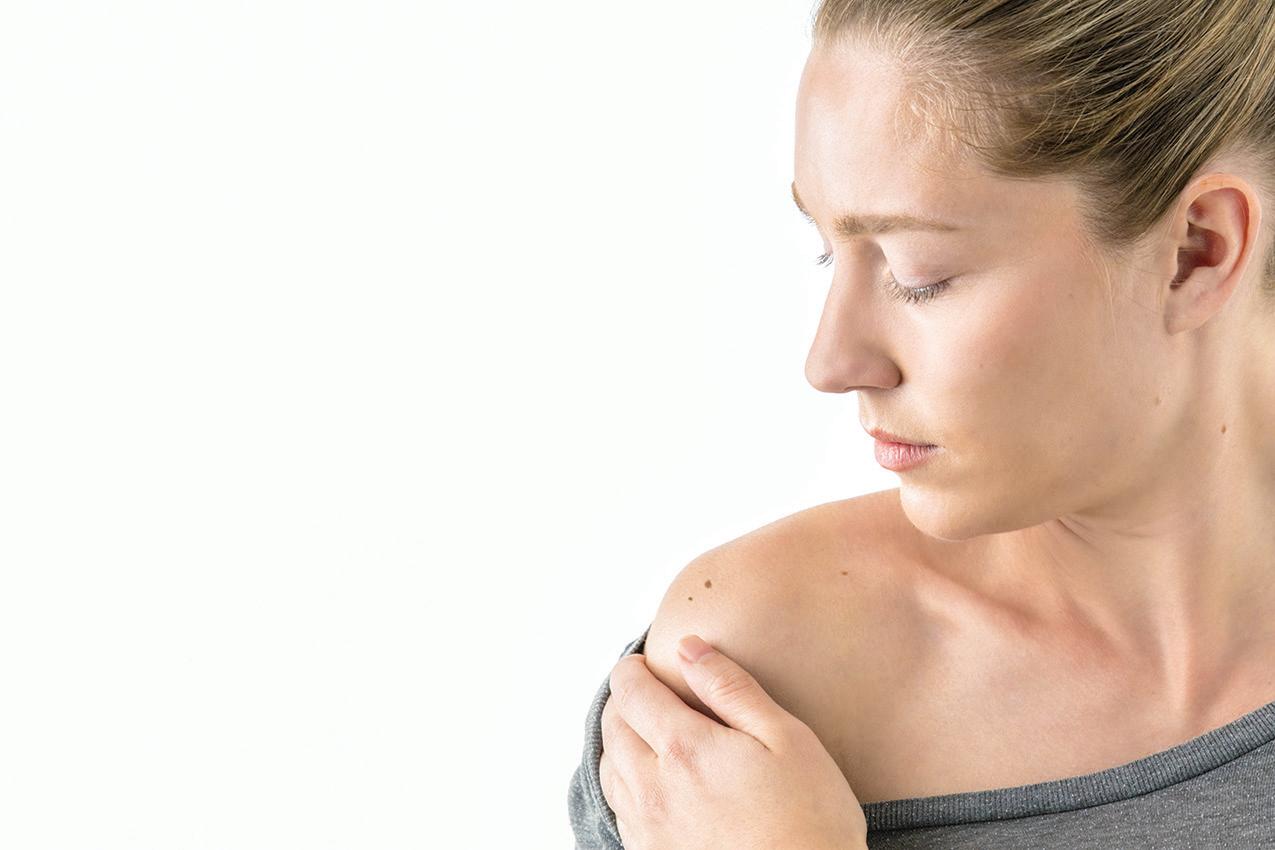
• E (Evolved): Moles or growths resulting from melanoma evolve in size or thickness.
Many people, adults and children alike, are familiar with the Hans Christian Andersen fairy tale “The Ugly Duckling.” That beloved story is one to remember when thinking of melanoma. According to the MRA, a mole that does not look like the rest of the moles on an individual’s body could be indicative of melanoma.
Melanoma is potentially deadly and rates of the disease are on the rise. The presence of any the aforementioned signs should be brought to the attention of a health care professional. More information about melanoma can be found at curemelanoma.org.
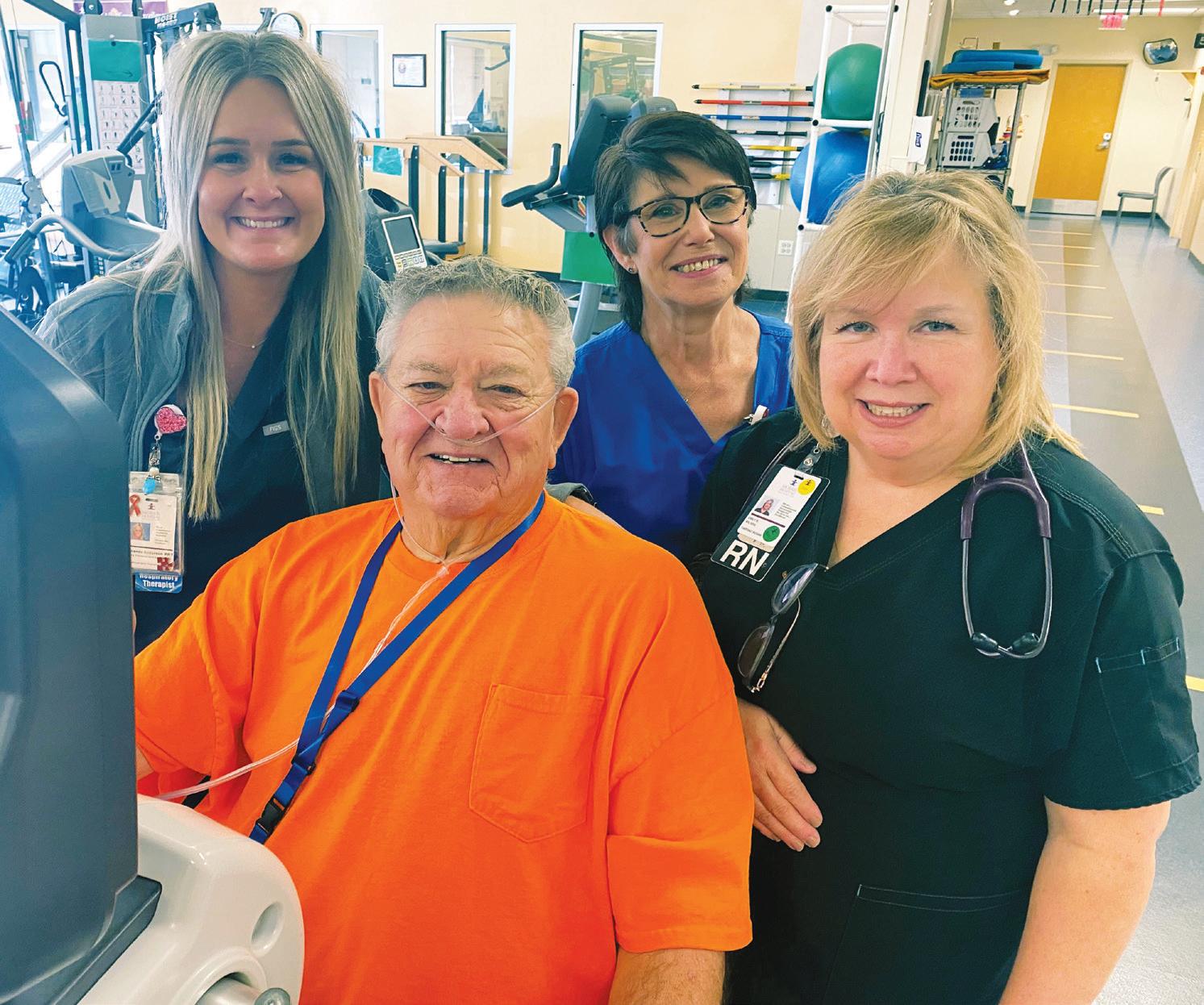
With help from respiratory therapists and registered nurses with Morris Hospital’s Pulmonary Rehabilitation program, 81-year-old Bill Button of Morris has significantly improved his quality of life.
Bill Button remembers his first encounter with Morris Hospital’s Pulmonary Rehabilitation program: he was not happy to be there. He admits he was even a little mad at the nurses and respiratory therapists for making him exercise, and he gave them a hard time.
It didn’t take long for Button to realize that what they were asking him to do was actually helping. Today, the 81-year-old Morris man is one of Pulmonary Rehab’s biggest cheerleaders.
“I tell everyone who comes in, ‘Just do what they tell you and you’ll look and feel better,’” he says.
Button first started his journey in 2022 when he noticed he was having trouble breathing due to chronic obstructive pulmonary disease. He recalls barely being able to finish a six-minute physical test on his first visit to Pulmonary Rehab.
“The more we tried to increase Bill’s
exercises, his oxygen levels would drop,” says Patti Holmberg, RN, Pulmonary Rehabilitation Charge Nurse at Morris Hospital.
The Pulmonary Rehab team recommended oxygen, a move that initially angered Button. But they encouraged him to “trust the process.” Placing Button on oxygen would allow him to continue with rehab, which was needed to help build back his physical and lung strength.
When Button first started Pulmonary Rehab, he was using 4 liters of oxygen every time he exercised and throughout the day. As he slowly rebuilt his strength, his dependence on oxygen decreased. Today, he rarely uses oxygen during the day and can even go on a one-mile walk or play a round of golf without using any oxygen at all.
“I do ride in a golf cart, but I couldn’t even play before without oxygen,” he said. Although he still uses oxygen at night,
Button has been able to lower his dose significantly. He has also lost 60 pounds since starting Pulmonary Rehab, and he was able to decrease the dosage of his diabetes medication.
“I think it’s great,” Button’s wife, Carol said. “My gosh, to go from being on oxygen 24 hours a day and not being able to do much to the way he is now …. It’s terrific.”
The key to Button’s success?
“He kept coming to rehab,” Holmberg says. “He kept exercising.”
After graduating from Phase 2 pulmonary rehabilitation, Button opted to continue with Morris Hospital’s Phase 3 pulmonary rehabilitation, which offers an open gym style, supervised exercise program twice weekly so graduates of Phase 2 can continue to strengthen and improve their lung strength.
Today as Button walks the indoor track in the rehab gym, he stops to encourage new patients by sharing his story, letting them know that the small steps they take today will make a difference. He tells them that when he first started rehab, he could only walk about four laps around the rehab track. Today he does 55. He also lets new patients know that the rehab team is here to help.
“They saved my life,” he adds. “If it wasn’t for them, I don’t know where I’d be.”
Morris Hospital’s Pulmonary Rehabilitation program is for individuals who have been diagnosed with a medical condition that affects their breathing, such as chronic obstructive pulmonary disease (COPD), pulmonary fibrosis, emphysema, asthma, shortness of breath, cystic fibrosis, hypoxemia or pneumonia. A physician’s order is required to participate. To learn more, go to morrishospital.org/ pulmonaryrehab or call 815-705-7837.

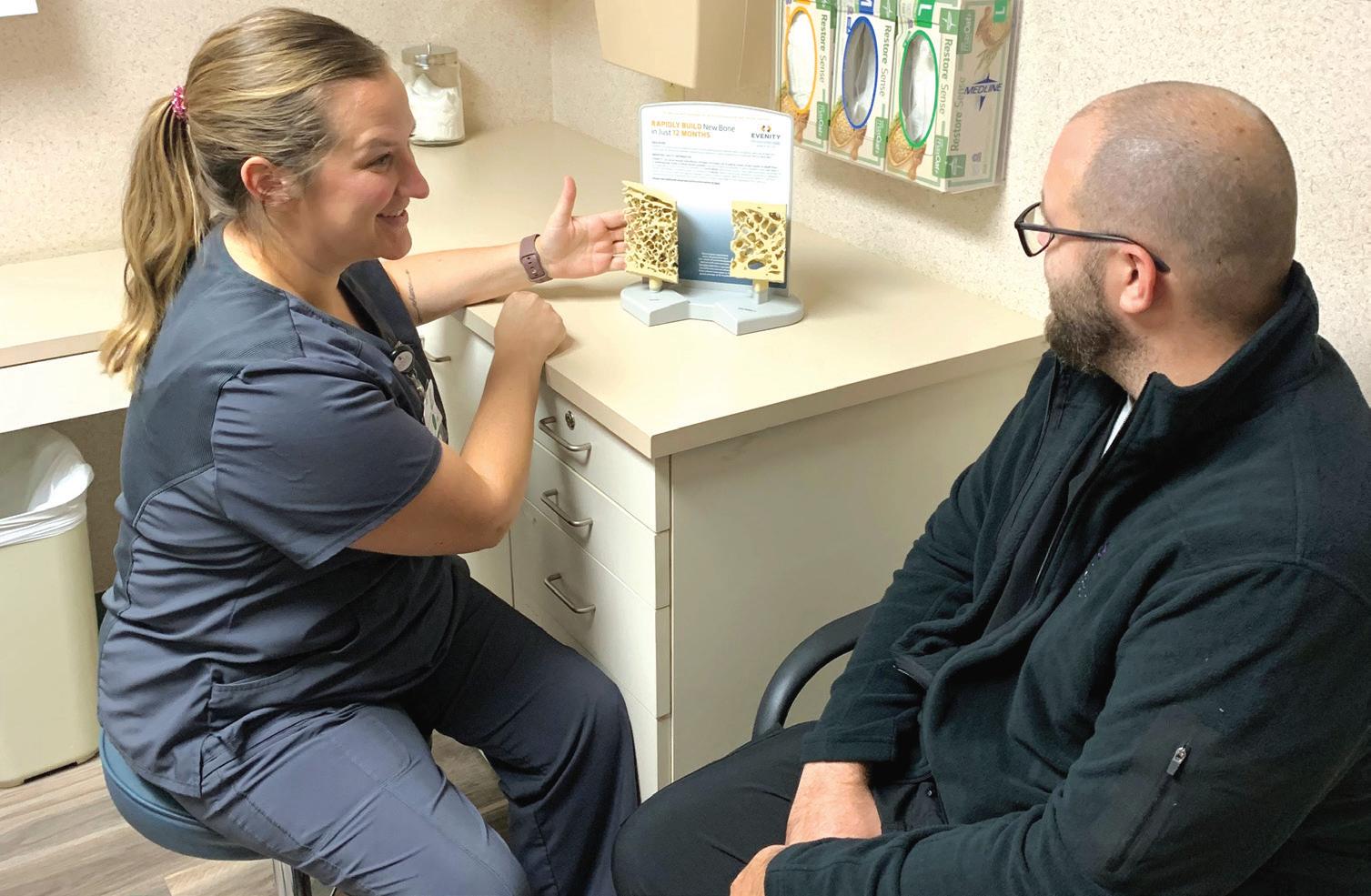
Nurse Practitioner Taelor Stuedemann discusses the risk factors and treatment options for osteoporosis with a patient in the Osteoporosis Management Program at the Morris Hospital Orthopedics & Sports Medicine office in Morris.
Morris Hospital & Healthcare Centers offers a new service to help patients better manage osteoporosis, a bone density disease that develops when bone mineral density and bone mass decreases, or when the quality or structure of bone changes. While one out of every 10 adults over the age of 50 develops osteoporosis, most people do not know they have the condition until they break or fracture a bone.
“Our orthopedics and sports medicine providers often see patients with osteoporosis related fractures or breaks that could have been prevented with better management of their condition,” says Taelor Stuedemann, a nurse practitioner with Morris Hospital Orthopedics & Sports Medicine who leads the new Osteoporosis Management Program. “It is important for people to know about osteoporosis so they can recognize risk factors within themselves or loved ones and then seek treatment. The goal of our program is to reduce breaks and fractures through earlier diagnosis and improved management of the condition.”
What is osteoporosis?
Osteoporosis develops when bone mineral density and bone mass decreases, or when the quality or structure of bone changes.
“Healthy bones are considerably more dense and strong compared to bones impacted by osteoporosis,” explains
Stuedemann. “While heathy bones can bear more weight and better absorb different kinds of impact, bones with osteoporosis are much more fragile and weaker.”
Who is at risk?
While osteoporosis has no symptoms, certain risk factors can increase the possibility of developing the condition. Risk factors can include:
• Being a woman age 65 or older
• Being a man age 70 or older
• a family history of osteoporosis
• low testosterone levels
• a history of bariatric surgery
• a history of eating disorders
• long-term smoking or alcohol abuse
• previous fragility fractures or multiple fractures
Why is it important to manage osteoporosis?
While there is currently no cure for osteoporosis, consistent treatment can reduce the severity of the condition, thus reducing the risk of experiencing a break or fracture. Untreated osteoporosis, on the other hand, can be devastating over time.
“Osteoporosis can develop in any bone but happens most often in the bones of the hip, spine, forearm and wrist,”
explains Stuedemann. “Severe injuries to these areas can affect a person’s ability to live independently, especially for elderly individuals.”
“When a fracture does occur in a person with osteoporosis, the recovery can take significantly longer since the bone is already weak,” she adds.
If the break cycle is repeated, overtime it can lead to bone collapse, resulting in lifelong pain.
“Patients who do not manage their osteoporosis often have severe mobility issues and may not be able to return to their everyday routine,” she says.
Patients start Morris Hospital’s Osteoporosis Management Program by meeting oneon-one with the nurse practitioner at the Orthopedics & Sports Medicine office in Morris where they discuss their medical history.
If a pattern of breaks or fractures is present in the patient’s history, a DEXA scan may be ordered to learn more about the bone’s density or strength. Bloodwork may also be used to gain more insight into the patient’s medical history.
Treatment for osteoporosis depends on the severity of the diagnosis, with some patients needing multiple methods to manage their condition, including medication, injections, physical therapy, and life style changes such as healthy eating habits and consistent exercise.
Patients can be referred to the program by a provider, or they can self-refer if they are at risk for osteoporosis.
Individuals who have risk factors or a family history of osteoporosis are encouraged to talk to their primary care provider. Or, call Morris Hospital Orthopedics & Sports Medicine at 815-942-4875 and ask for an appointment with the Osteoporosis Management Program or visit www.morrishospital.org/osteo.
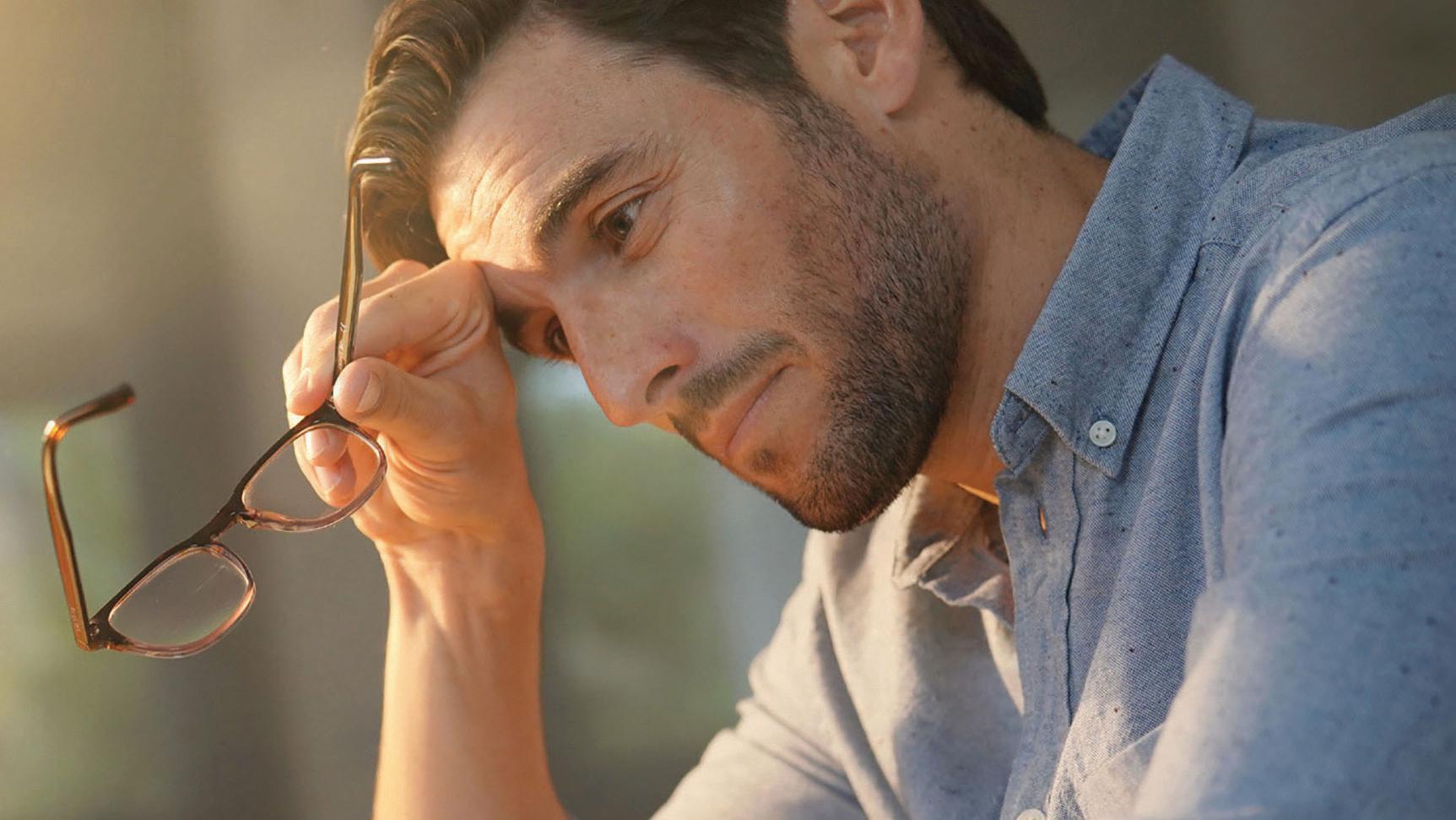


• Chest discomfort • Shortness of breath • Lightheadedness • Extreme fatigue • Racing or slow heartbeat
These are signs that something might not be right with your heart.
Our board certified cardiologists are experienced in diagnosing and treating heart problems using advanced capabilities and technology at Morris Hospital.
If you have a family history of heart disease or any concerns about your heart health, call 815-705-1000 today to schedule an appointment with a cardiologist.
Syed Ahmed, M.D., Mostafa Ghanim, M.D., Mary Menz, D.O. Alexander Green, M.D., Athar Saeed, M.D., Hershel Wix, M.D.
Office locations in Channahon, Dwight, Morris and Ottawa.
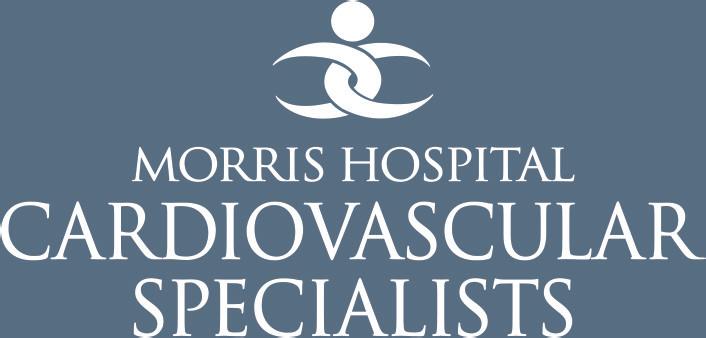
www.morrishospital.org/cvspecialists